BSBCNV502: Conveyancing Transactions - Interpreting Legal Documents
VerifiedAdded on 2023/06/10
|32
|13119
|266
Homework Assignment
AI Summary
This assignment solution focuses on property transactions and the interpretation of legal documents within the context of conveyancing, addressing key aspects such as ownership and change of ownership. It explores the procedures involved in initiating transactions related to real estate, personal property, and business, emphasizing the legal requirements at state, regional, and international levels. The solution delves into the importance of proper documentation and communication in legal processes, distinguishing between real property (immovable) and personal property (moveable). Key topics covered include defining 'desired outcomes' and how they are established, the purpose and use of 'file notes,' and a comprehensive list of fees, taxes, and rebates relevant to conveyancing, along with methods of communicating these to clients. Furthermore, it examines how advice and recommendations are communicated to and confirmed by clients, source documents in business transactions, regulatory bodies related to the conveyancing industry, invoicing and follow-up procedures, and the filing and archiving processes within an organization. The solution also addresses compliance requirements, notification procedures for completing client transactions, accuracy checks for information, the definitions of 'authority to proceed' and 'confirmation notice,' policies for closing files, and measures to ensure adherence to regulatory requirements. Finally, it discusses conditions related to the Nomination clause in purchase contracts, assurances provided by effective internal control systems, and the policy/procedure for potential conflicts of interest.

Diploma in Conveyancing
Paraphrase This Document
Need a fresh take? Get an instant paraphrase of this document with our AI Paraphraser
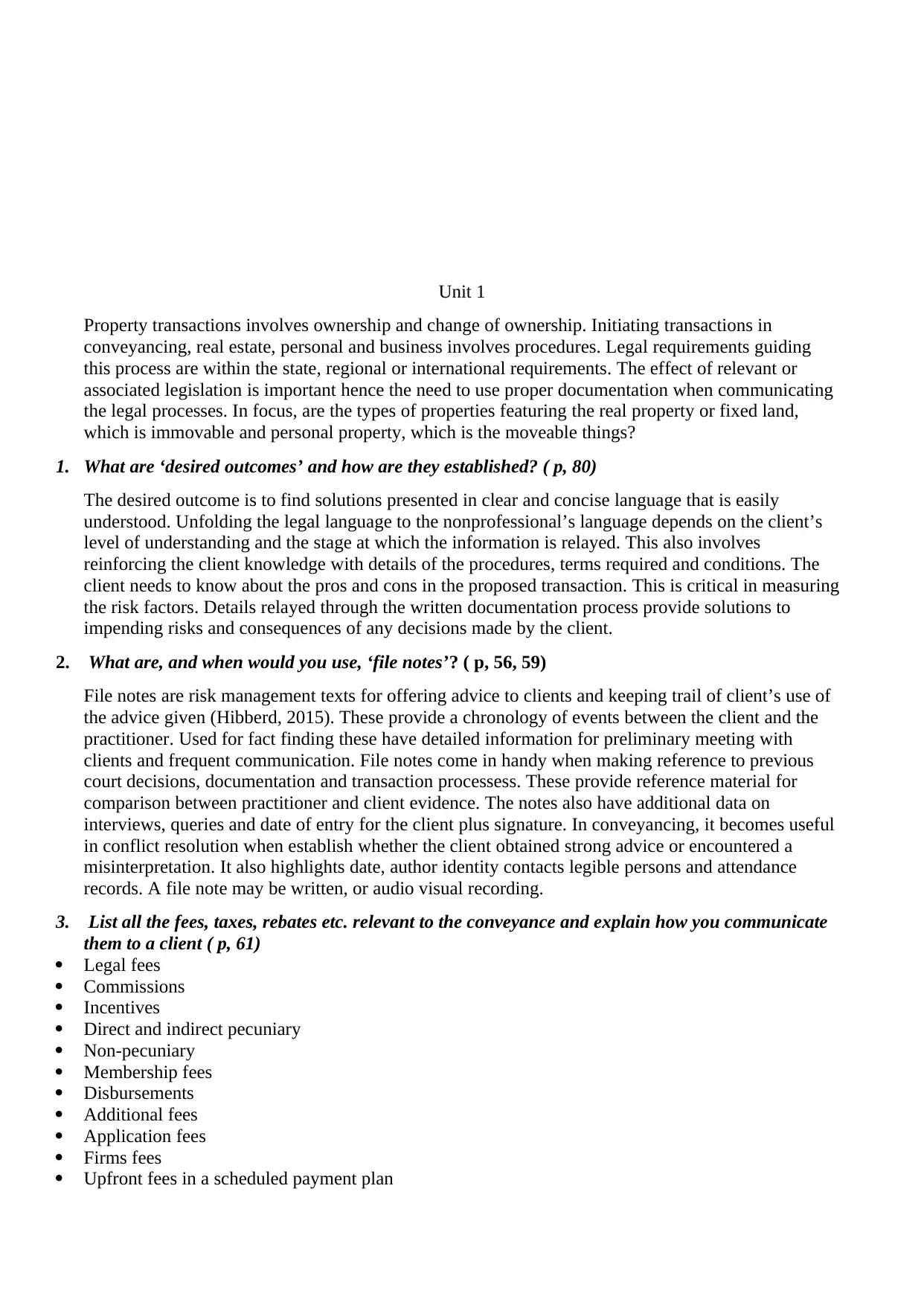
Unit 1
Property transactions involves ownership and change of ownership. Initiating transactions in
conveyancing, real estate, personal and business involves procedures. Legal requirements guiding
this process are within the state, regional or international requirements. The effect of relevant or
associated legislation is important hence the need to use proper documentation when communicating
the legal processes. In focus, are the types of properties featuring the real property or fixed land,
which is immovable and personal property, which is the moveable things?
1. What are ‘desired outcomes’ and how are they established? ( p, 80)
The desired outcome is to find solutions presented in clear and concise language that is easily
understood. Unfolding the legal language to the nonprofessional’s language depends on the client’s
level of understanding and the stage at which the information is relayed. This also involves
reinforcing the client knowledge with details of the procedures, terms required and conditions. The
client needs to know about the pros and cons in the proposed transaction. This is critical in measuring
the risk factors. Details relayed through the written documentation process provide solutions to
impending risks and consequences of any decisions made by the client.
2. What are, and when would you use, ‘file notes’? ( p, 56, 59)
File notes are risk management texts for offering advice to clients and keeping trail of client’s use of
the advice given (Hibberd, 2015). These provide a chronology of events between the client and the
practitioner. Used for fact finding these have detailed information for preliminary meeting with
clients and frequent communication. File notes come in handy when making reference to previous
court decisions, documentation and transaction processess. These provide reference material for
comparison between practitioner and client evidence. The notes also have additional data on
interviews, queries and date of entry for the client plus signature. In conveyancing, it becomes useful
in conflict resolution when establish whether the client obtained strong advice or encountered a
misinterpretation. It also highlights date, author identity contacts legible persons and attendance
records. A file note may be written, or audio visual recording.
3. List all the fees, taxes, rebates etc. relevant to the conveyance and explain how you communicate
them to a client ( p, 61)
Legal fees
Commissions
Incentives
Direct and indirect pecuniary
Non-pecuniary
Membership fees
Disbursements
Additional fees
Application fees
Firms fees
Upfront fees in a scheduled payment plan
Property transactions involves ownership and change of ownership. Initiating transactions in
conveyancing, real estate, personal and business involves procedures. Legal requirements guiding
this process are within the state, regional or international requirements. The effect of relevant or
associated legislation is important hence the need to use proper documentation when communicating
the legal processes. In focus, are the types of properties featuring the real property or fixed land,
which is immovable and personal property, which is the moveable things?
1. What are ‘desired outcomes’ and how are they established? ( p, 80)
The desired outcome is to find solutions presented in clear and concise language that is easily
understood. Unfolding the legal language to the nonprofessional’s language depends on the client’s
level of understanding and the stage at which the information is relayed. This also involves
reinforcing the client knowledge with details of the procedures, terms required and conditions. The
client needs to know about the pros and cons in the proposed transaction. This is critical in measuring
the risk factors. Details relayed through the written documentation process provide solutions to
impending risks and consequences of any decisions made by the client.
2. What are, and when would you use, ‘file notes’? ( p, 56, 59)
File notes are risk management texts for offering advice to clients and keeping trail of client’s use of
the advice given (Hibberd, 2015). These provide a chronology of events between the client and the
practitioner. Used for fact finding these have detailed information for preliminary meeting with
clients and frequent communication. File notes come in handy when making reference to previous
court decisions, documentation and transaction processess. These provide reference material for
comparison between practitioner and client evidence. The notes also have additional data on
interviews, queries and date of entry for the client plus signature. In conveyancing, it becomes useful
in conflict resolution when establish whether the client obtained strong advice or encountered a
misinterpretation. It also highlights date, author identity contacts legible persons and attendance
records. A file note may be written, or audio visual recording.
3. List all the fees, taxes, rebates etc. relevant to the conveyance and explain how you communicate
them to a client ( p, 61)
Legal fees
Commissions
Incentives
Direct and indirect pecuniary
Non-pecuniary
Membership fees
Disbursements
Additional fees
Application fees
Firms fees
Upfront fees in a scheduled payment plan
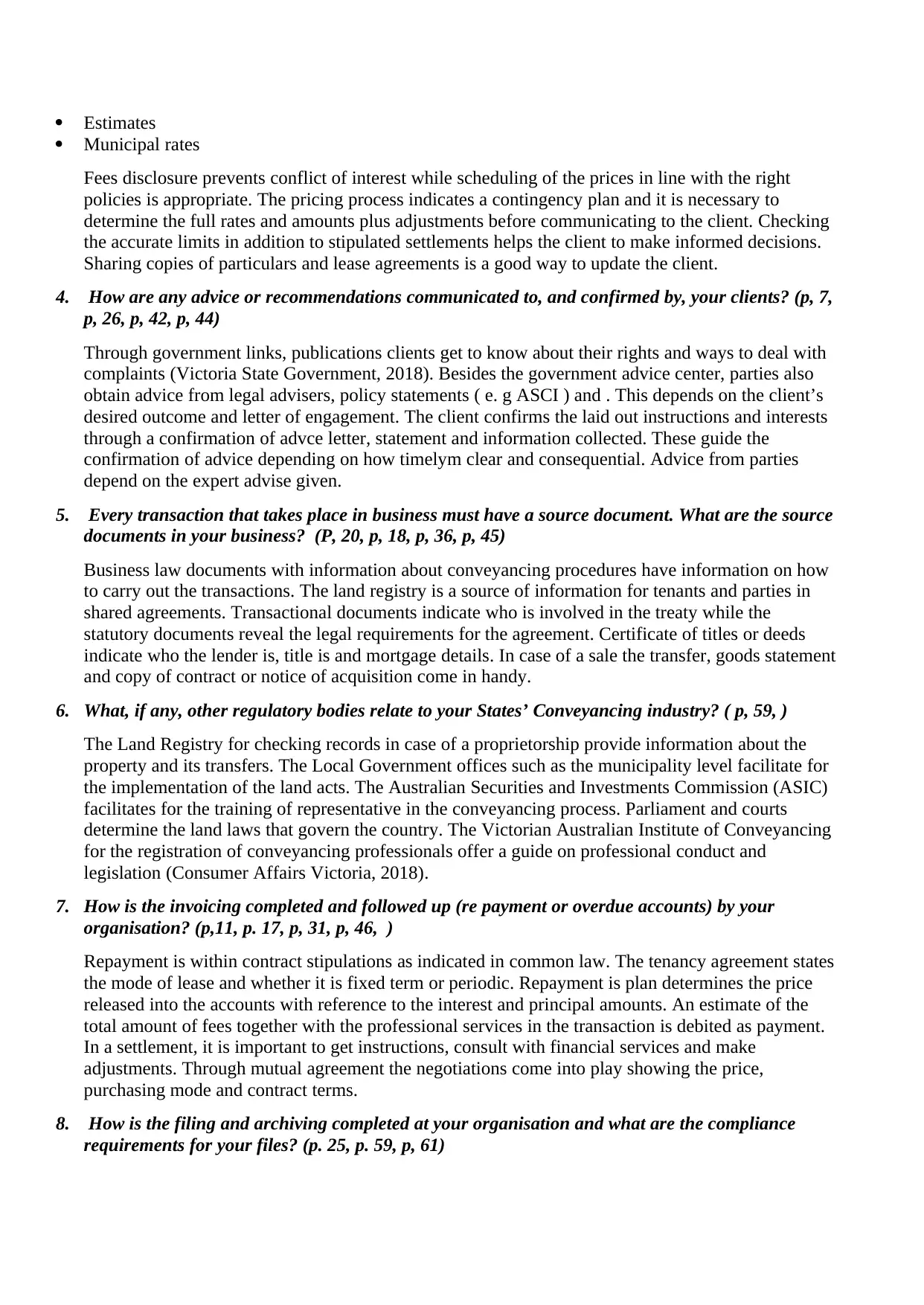
Estimates
Municipal rates
Fees disclosure prevents conflict of interest while scheduling of the prices in line with the right
policies is appropriate. The pricing process indicates a contingency plan and it is necessary to
determine the full rates and amounts plus adjustments before communicating to the client. Checking
the accurate limits in addition to stipulated settlements helps the client to make informed decisions.
Sharing copies of particulars and lease agreements is a good way to update the client.
4. How are any advice or recommendations communicated to, and confirmed by, your clients? (p, 7,
p, 26, p, 42, p, 44)
Through government links, publications clients get to know about their rights and ways to deal with
complaints (Victoria State Government, 2018). Besides the government advice center, parties also
obtain advice from legal advisers, policy statements ( e. g ASCI ) and . This depends on the client’s
desired outcome and letter of engagement. The client confirms the laid out instructions and interests
through a confirmation of advce letter, statement and information collected. These guide the
confirmation of advice depending on how timelym clear and consequential. Advice from parties
depend on the expert advise given.
5. Every transaction that takes place in business must have a source document. What are the source
documents in your business? (P, 20, p, 18, p, 36, p, 45)
Business law documents with information about conveyancing procedures have information on how
to carry out the transactions. The land registry is a source of information for tenants and parties in
shared agreements. Transactional documents indicate who is involved in the treaty while the
statutory documents reveal the legal requirements for the agreement. Certificate of titles or deeds
indicate who the lender is, title is and mortgage details. In case of a sale the transfer, goods statement
and copy of contract or notice of acquisition come in handy.
6. What, if any, other regulatory bodies relate to your States’ Conveyancing industry? ( p, 59, )
The Land Registry for checking records in case of a proprietorship provide information about the
property and its transfers. The Local Government offices such as the municipality level facilitate for
the implementation of the land acts. The Australian Securities and Investments Commission (ASIC)
facilitates for the training of representative in the conveyancing process. Parliament and courts
determine the land laws that govern the country. The Victorian Australian Institute of Conveyancing
for the registration of conveyancing professionals offer a guide on professional conduct and
legislation (Consumer Affairs Victoria, 2018).
7. How is the invoicing completed and followed up (re payment or overdue accounts) by your
organisation? (p,11, p. 17, p, 31, p, 46, )
Repayment is within contract stipulations as indicated in common law. The tenancy agreement states
the mode of lease and whether it is fixed term or periodic. Repayment is plan determines the price
released into the accounts with reference to the interest and principal amounts. An estimate of the
total amount of fees together with the professional services in the transaction is debited as payment.
In a settlement, it is important to get instructions, consult with financial services and make
adjustments. Through mutual agreement the negotiations come into play showing the price,
purchasing mode and contract terms.
8. How is the filing and archiving completed at your organisation and what are the compliance
requirements for your files? (p. 25, p. 59, p, 61)
Municipal rates
Fees disclosure prevents conflict of interest while scheduling of the prices in line with the right
policies is appropriate. The pricing process indicates a contingency plan and it is necessary to
determine the full rates and amounts plus adjustments before communicating to the client. Checking
the accurate limits in addition to stipulated settlements helps the client to make informed decisions.
Sharing copies of particulars and lease agreements is a good way to update the client.
4. How are any advice or recommendations communicated to, and confirmed by, your clients? (p, 7,
p, 26, p, 42, p, 44)
Through government links, publications clients get to know about their rights and ways to deal with
complaints (Victoria State Government, 2018). Besides the government advice center, parties also
obtain advice from legal advisers, policy statements ( e. g ASCI ) and . This depends on the client’s
desired outcome and letter of engagement. The client confirms the laid out instructions and interests
through a confirmation of advce letter, statement and information collected. These guide the
confirmation of advice depending on how timelym clear and consequential. Advice from parties
depend on the expert advise given.
5. Every transaction that takes place in business must have a source document. What are the source
documents in your business? (P, 20, p, 18, p, 36, p, 45)
Business law documents with information about conveyancing procedures have information on how
to carry out the transactions. The land registry is a source of information for tenants and parties in
shared agreements. Transactional documents indicate who is involved in the treaty while the
statutory documents reveal the legal requirements for the agreement. Certificate of titles or deeds
indicate who the lender is, title is and mortgage details. In case of a sale the transfer, goods statement
and copy of contract or notice of acquisition come in handy.
6. What, if any, other regulatory bodies relate to your States’ Conveyancing industry? ( p, 59, )
The Land Registry for checking records in case of a proprietorship provide information about the
property and its transfers. The Local Government offices such as the municipality level facilitate for
the implementation of the land acts. The Australian Securities and Investments Commission (ASIC)
facilitates for the training of representative in the conveyancing process. Parliament and courts
determine the land laws that govern the country. The Victorian Australian Institute of Conveyancing
for the registration of conveyancing professionals offer a guide on professional conduct and
legislation (Consumer Affairs Victoria, 2018).
7. How is the invoicing completed and followed up (re payment or overdue accounts) by your
organisation? (p,11, p. 17, p, 31, p, 46, )
Repayment is within contract stipulations as indicated in common law. The tenancy agreement states
the mode of lease and whether it is fixed term or periodic. Repayment is plan determines the price
released into the accounts with reference to the interest and principal amounts. An estimate of the
total amount of fees together with the professional services in the transaction is debited as payment.
In a settlement, it is important to get instructions, consult with financial services and make
adjustments. Through mutual agreement the negotiations come into play showing the price,
purchasing mode and contract terms.
8. How is the filing and archiving completed at your organisation and what are the compliance
requirements for your files? (p. 25, p. 59, p, 61)
⊘ This is a preview!⊘
Do you want full access?
Subscribe today to unlock all pages.

Trusted by 1+ million students worldwide
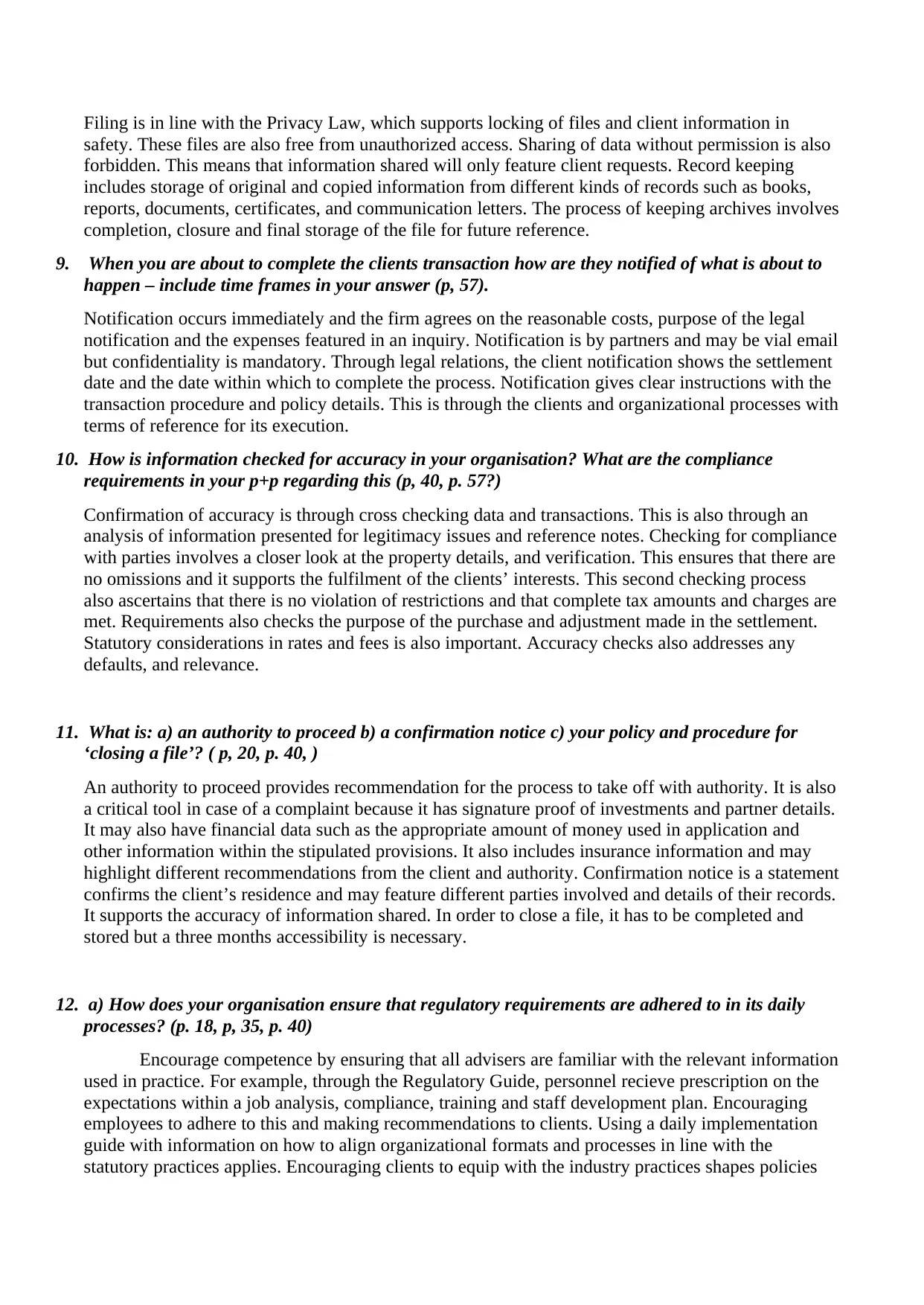
Filing is in line with the Privacy Law, which supports locking of files and client information in
safety. These files are also free from unauthorized access. Sharing of data without permission is also
forbidden. This means that information shared will only feature client requests. Record keeping
includes storage of original and copied information from different kinds of records such as books,
reports, documents, certificates, and communication letters. The process of keeping archives involves
completion, closure and final storage of the file for future reference.
9. When you are about to complete the clients transaction how are they notified of what is about to
happen – include time frames in your answer (p, 57).
Notification occurs immediately and the firm agrees on the reasonable costs, purpose of the legal
notification and the expenses featured in an inquiry. Notification is by partners and may be vial email
but confidentiality is mandatory. Through legal relations, the client notification shows the settlement
date and the date within which to complete the process. Notification gives clear instructions with the
transaction procedure and policy details. This is through the clients and organizational processes with
terms of reference for its execution.
10. How is information checked for accuracy in your organisation? What are the compliance
requirements in your p+p regarding this (p, 40, p. 57?)
Confirmation of accuracy is through cross checking data and transactions. This is also through an
analysis of information presented for legitimacy issues and reference notes. Checking for compliance
with parties involves a closer look at the property details, and verification. This ensures that there are
no omissions and it supports the fulfilment of the clients’ interests. This second checking process
also ascertains that there is no violation of restrictions and that complete tax amounts and charges are
met. Requirements also checks the purpose of the purchase and adjustment made in the settlement.
Statutory considerations in rates and fees is also important. Accuracy checks also addresses any
defaults, and relevance.
11. What is: a) an authority to proceed b) a confirmation notice c) your policy and procedure for
‘closing a file’? ( p, 20, p. 40, )
An authority to proceed provides recommendation for the process to take off with authority. It is also
a critical tool in case of a complaint because it has signature proof of investments and partner details.
It may also have financial data such as the appropriate amount of money used in application and
other information within the stipulated provisions. It also includes insurance information and may
highlight different recommendations from the client and authority. Confirmation notice is a statement
confirms the client’s residence and may feature different parties involved and details of their records.
It supports the accuracy of information shared. In order to close a file, it has to be completed and
stored but a three months accessibility is necessary.
12. a) How does your organisation ensure that regulatory requirements are adhered to in its daily
processes? (p. 18, p, 35, p. 40)
Encourage competence by ensuring that all advisers are familiar with the relevant information
used in practice. For example, through the Regulatory Guide, personnel recieve prescription on the
expectations within a job analysis, compliance, training and staff development plan. Encouraging
employees to adhere to this and making recommendations to clients. Using a daily implementation
guide with information on how to align organizational formats and processes in line with the
statutory practices applies. Encouraging clients to equip with the industry practices shapes policies
safety. These files are also free from unauthorized access. Sharing of data without permission is also
forbidden. This means that information shared will only feature client requests. Record keeping
includes storage of original and copied information from different kinds of records such as books,
reports, documents, certificates, and communication letters. The process of keeping archives involves
completion, closure and final storage of the file for future reference.
9. When you are about to complete the clients transaction how are they notified of what is about to
happen – include time frames in your answer (p, 57).
Notification occurs immediately and the firm agrees on the reasonable costs, purpose of the legal
notification and the expenses featured in an inquiry. Notification is by partners and may be vial email
but confidentiality is mandatory. Through legal relations, the client notification shows the settlement
date and the date within which to complete the process. Notification gives clear instructions with the
transaction procedure and policy details. This is through the clients and organizational processes with
terms of reference for its execution.
10. How is information checked for accuracy in your organisation? What are the compliance
requirements in your p+p regarding this (p, 40, p. 57?)
Confirmation of accuracy is through cross checking data and transactions. This is also through an
analysis of information presented for legitimacy issues and reference notes. Checking for compliance
with parties involves a closer look at the property details, and verification. This ensures that there are
no omissions and it supports the fulfilment of the clients’ interests. This second checking process
also ascertains that there is no violation of restrictions and that complete tax amounts and charges are
met. Requirements also checks the purpose of the purchase and adjustment made in the settlement.
Statutory considerations in rates and fees is also important. Accuracy checks also addresses any
defaults, and relevance.
11. What is: a) an authority to proceed b) a confirmation notice c) your policy and procedure for
‘closing a file’? ( p, 20, p. 40, )
An authority to proceed provides recommendation for the process to take off with authority. It is also
a critical tool in case of a complaint because it has signature proof of investments and partner details.
It may also have financial data such as the appropriate amount of money used in application and
other information within the stipulated provisions. It also includes insurance information and may
highlight different recommendations from the client and authority. Confirmation notice is a statement
confirms the client’s residence and may feature different parties involved and details of their records.
It supports the accuracy of information shared. In order to close a file, it has to be completed and
stored but a three months accessibility is necessary.
12. a) How does your organisation ensure that regulatory requirements are adhered to in its daily
processes? (p. 18, p, 35, p. 40)
Encourage competence by ensuring that all advisers are familiar with the relevant information
used in practice. For example, through the Regulatory Guide, personnel recieve prescription on the
expectations within a job analysis, compliance, training and staff development plan. Encouraging
employees to adhere to this and making recommendations to clients. Using a daily implementation
guide with information on how to align organizational formats and processes in line with the
statutory practices applies. Encouraging clients to equip with the industry practices shapes policies
Paraphrase This Document
Need a fresh take? Get an instant paraphrase of this document with our AI Paraphraser
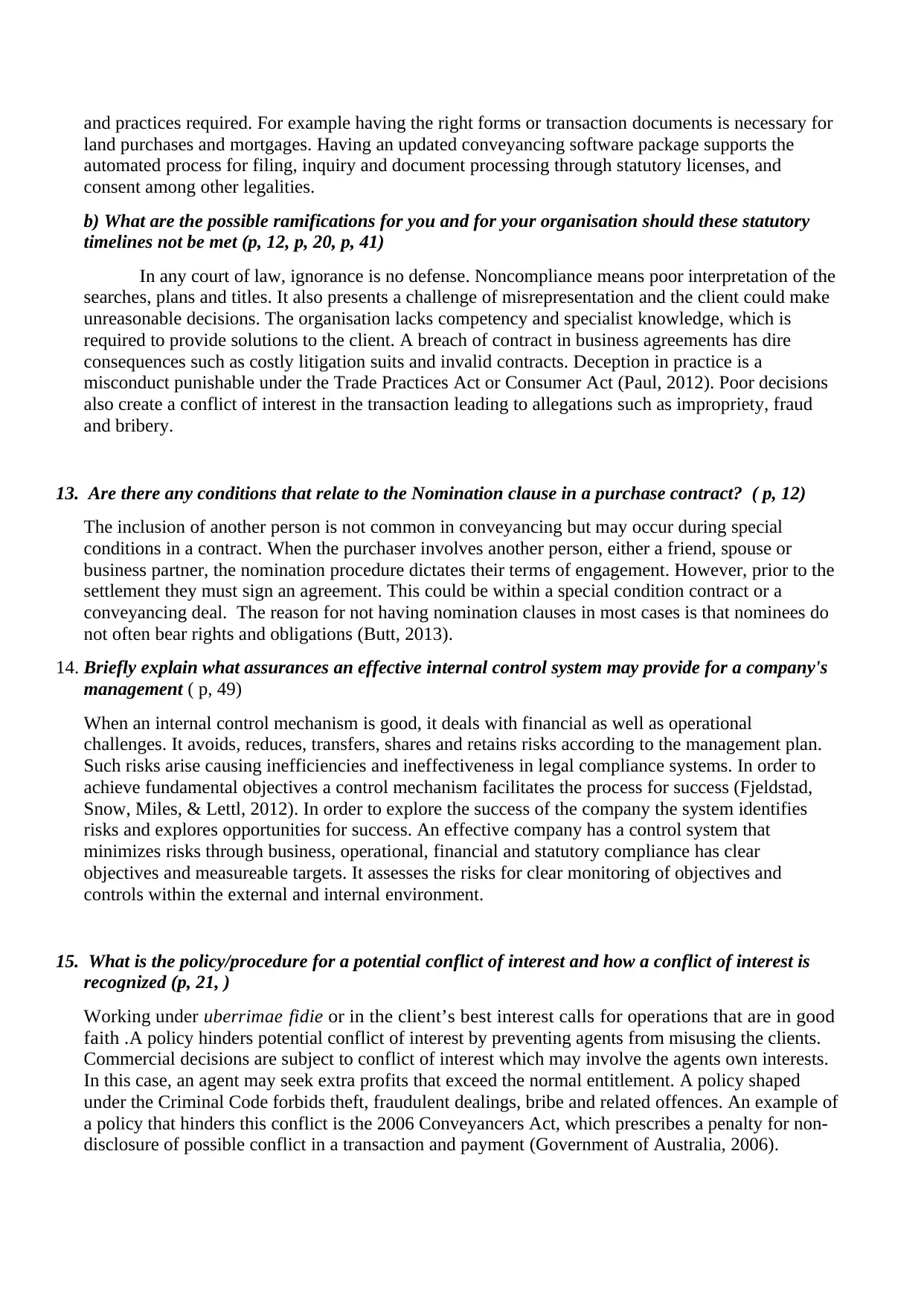
and practices required. For example having the right forms or transaction documents is necessary for
land purchases and mortgages. Having an updated conveyancing software package supports the
automated process for filing, inquiry and document processing through statutory licenses, and
consent among other legalities.
b) What are the possible ramifications for you and for your organisation should these statutory
timelines not be met (p, 12, p, 20, p, 41)
In any court of law, ignorance is no defense. Noncompliance means poor interpretation of the
searches, plans and titles. It also presents a challenge of misrepresentation and the client could make
unreasonable decisions. The organisation lacks competency and specialist knowledge, which is
required to provide solutions to the client. A breach of contract in business agreements has dire
consequences such as costly litigation suits and invalid contracts. Deception in practice is a
misconduct punishable under the Trade Practices Act or Consumer Act (Paul, 2012). Poor decisions
also create a conflict of interest in the transaction leading to allegations such as impropriety, fraud
and bribery.
13. Are there any conditions that relate to the Nomination clause in a purchase contract? ( p, 12)
The inclusion of another person is not common in conveyancing but may occur during special
conditions in a contract. When the purchaser involves another person, either a friend, spouse or
business partner, the nomination procedure dictates their terms of engagement. However, prior to the
settlement they must sign an agreement. This could be within a special condition contract or a
conveyancing deal. The reason for not having nomination clauses in most cases is that nominees do
not often bear rights and obligations (Butt, 2013).
14. Briefly explain what assurances an effective internal control system may provide for a company's
management ( p, 49)
When an internal control mechanism is good, it deals with financial as well as operational
challenges. It avoids, reduces, transfers, shares and retains risks according to the management plan.
Such risks arise causing inefficiencies and ineffectiveness in legal compliance systems. In order to
achieve fundamental objectives a control mechanism facilitates the process for success (Fjeldstad,
Snow, Miles, & Lettl, 2012). In order to explore the success of the company the system identifies
risks and explores opportunities for success. An effective company has a control system that
minimizes risks through business, operational, financial and statutory compliance has clear
objectives and measureable targets. It assesses the risks for clear monitoring of objectives and
controls within the external and internal environment.
15. What is the policy/procedure for a potential conflict of interest and how a conflict of interest is
recognized (p, 21, )
Working under uberrimae fi di e or in the client’s best interest calls for operations that are in good
faith .A policy hinders potential conflict of interest by preventing agents from misusing the clients.
Commercial decisions are subject to conflict of interest which may involve the agents own interests.
In this case, an agent may seek extra profits that exceed the normal entitlement. A policy shaped
under the Criminal Code forbids theft, fraudulent dealings, bribe and related offences. An example of
a policy that hinders this conflict is the 2006 Conveyancers Act, which prescribes a penalty for non-
disclosure of possible conflict in a transaction and payment (Government of Australia, 2006).
land purchases and mortgages. Having an updated conveyancing software package supports the
automated process for filing, inquiry and document processing through statutory licenses, and
consent among other legalities.
b) What are the possible ramifications for you and for your organisation should these statutory
timelines not be met (p, 12, p, 20, p, 41)
In any court of law, ignorance is no defense. Noncompliance means poor interpretation of the
searches, plans and titles. It also presents a challenge of misrepresentation and the client could make
unreasonable decisions. The organisation lacks competency and specialist knowledge, which is
required to provide solutions to the client. A breach of contract in business agreements has dire
consequences such as costly litigation suits and invalid contracts. Deception in practice is a
misconduct punishable under the Trade Practices Act or Consumer Act (Paul, 2012). Poor decisions
also create a conflict of interest in the transaction leading to allegations such as impropriety, fraud
and bribery.
13. Are there any conditions that relate to the Nomination clause in a purchase contract? ( p, 12)
The inclusion of another person is not common in conveyancing but may occur during special
conditions in a contract. When the purchaser involves another person, either a friend, spouse or
business partner, the nomination procedure dictates their terms of engagement. However, prior to the
settlement they must sign an agreement. This could be within a special condition contract or a
conveyancing deal. The reason for not having nomination clauses in most cases is that nominees do
not often bear rights and obligations (Butt, 2013).
14. Briefly explain what assurances an effective internal control system may provide for a company's
management ( p, 49)
When an internal control mechanism is good, it deals with financial as well as operational
challenges. It avoids, reduces, transfers, shares and retains risks according to the management plan.
Such risks arise causing inefficiencies and ineffectiveness in legal compliance systems. In order to
achieve fundamental objectives a control mechanism facilitates the process for success (Fjeldstad,
Snow, Miles, & Lettl, 2012). In order to explore the success of the company the system identifies
risks and explores opportunities for success. An effective company has a control system that
minimizes risks through business, operational, financial and statutory compliance has clear
objectives and measureable targets. It assesses the risks for clear monitoring of objectives and
controls within the external and internal environment.
15. What is the policy/procedure for a potential conflict of interest and how a conflict of interest is
recognized (p, 21, )
Working under uberrimae fi di e or in the client’s best interest calls for operations that are in good
faith .A policy hinders potential conflict of interest by preventing agents from misusing the clients.
Commercial decisions are subject to conflict of interest which may involve the agents own interests.
In this case, an agent may seek extra profits that exceed the normal entitlement. A policy shaped
under the Criminal Code forbids theft, fraudulent dealings, bribe and related offences. An example of
a policy that hinders this conflict is the 2006 Conveyancers Act, which prescribes a penalty for non-
disclosure of possible conflict in a transaction and payment (Government of Australia, 2006).
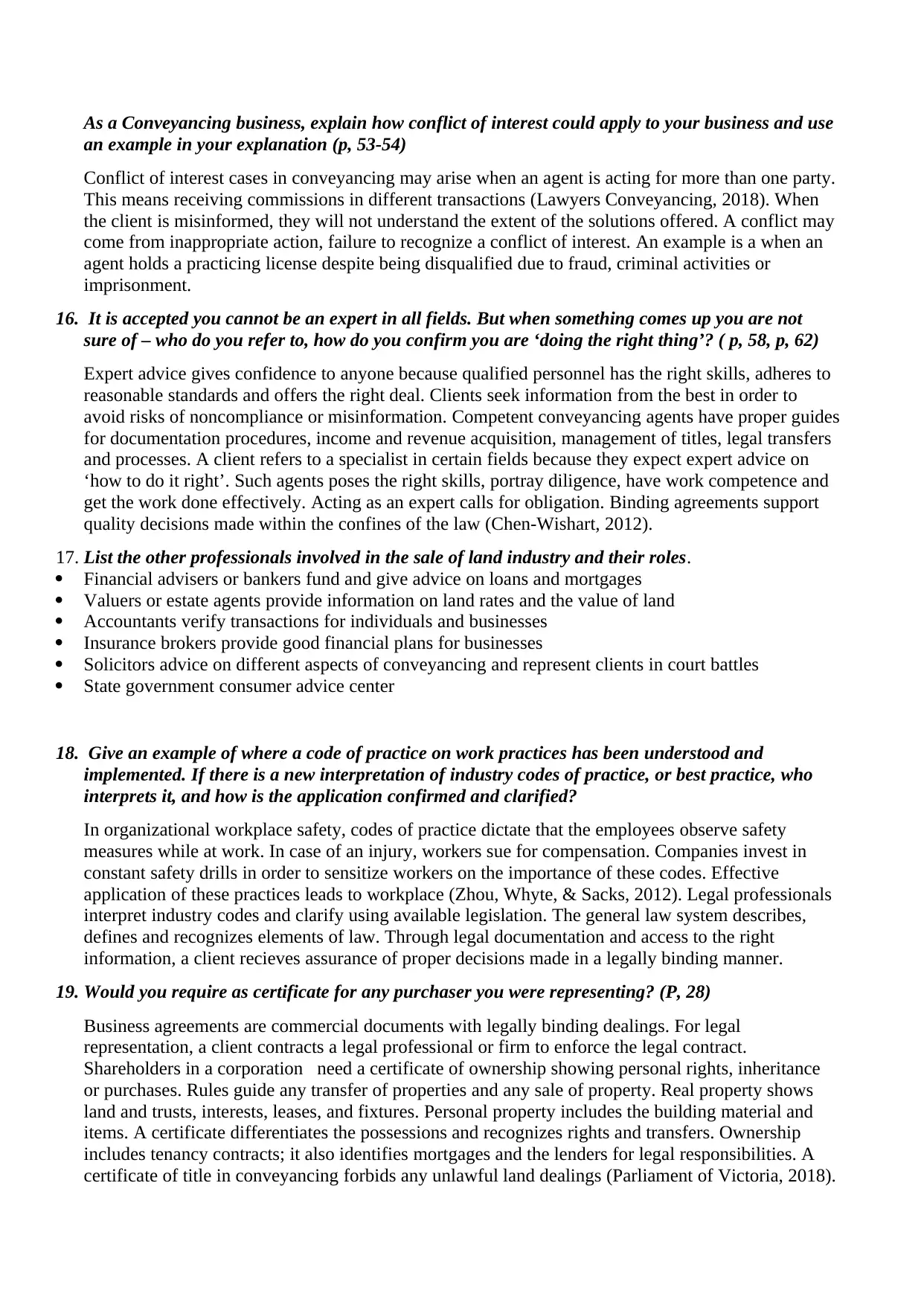
As a Conveyancing business, explain how conflict of interest could apply to your business and use
an example in your explanation (p, 53-54)
Conflict of interest cases in conveyancing may arise when an agent is acting for more than one party.
This means receiving commissions in different transactions (Lawyers Conveyancing, 2018). When
the client is misinformed, they will not understand the extent of the solutions offered. A conflict may
come from inappropriate action, failure to recognize a conflict of interest. An example is a when an
agent holds a practicing license despite being disqualified due to fraud, criminal activities or
imprisonment.
16. It is accepted you cannot be an expert in all fields. But when something comes up you are not
sure of – who do you refer to, how do you confirm you are ‘doing the right thing’? ( p, 58, p, 62)
Expert advice gives confidence to anyone because qualified personnel has the right skills, adheres to
reasonable standards and offers the right deal. Clients seek information from the best in order to
avoid risks of noncompliance or misinformation. Competent conveyancing agents have proper guides
for documentation procedures, income and revenue acquisition, management of titles, legal transfers
and processes. A client refers to a specialist in certain fields because they expect expert advice on
‘how to do it right’. Such agents poses the right skills, portray diligence, have work competence and
get the work done effectively. Acting as an expert calls for obligation. Binding agreements support
quality decisions made within the confines of the law (Chen-Wishart, 2012).
17. List the other professionals involved in the sale of land industry and their roles.
Financial advisers or bankers fund and give advice on loans and mortgages
Valuers or estate agents provide information on land rates and the value of land
Accountants verify transactions for individuals and businesses
Insurance brokers provide good financial plans for businesses
Solicitors advice on different aspects of conveyancing and represent clients in court battles
State government consumer advice center
18. Give an example of where a code of practice on work practices has been understood and
implemented. If there is a new interpretation of industry codes of practice, or best practice, who
interprets it, and how is the application confirmed and clarified?
In organizational workplace safety, codes of practice dictate that the employees observe safety
measures while at work. In case of an injury, workers sue for compensation. Companies invest in
constant safety drills in order to sensitize workers on the importance of these codes. Effective
application of these practices leads to workplace (Zhou, Whyte, & Sacks, 2012). Legal professionals
interpret industry codes and clarify using available legislation. The general law system describes,
defines and recognizes elements of law. Through legal documentation and access to the right
information, a client recieves assurance of proper decisions made in a legally binding manner.
19. Would you require as certificate for any purchaser you were representing? (P, 28)
Business agreements are commercial documents with legally binding dealings. For legal
representation, a client contracts a legal professional or firm to enforce the legal contract.
Shareholders in a corporation need a certificate of ownership showing personal rights, inheritance
or purchases. Rules guide any transfer of properties and any sale of property. Real property shows
land and trusts, interests, leases, and fixtures. Personal property includes the building material and
items. A certificate differentiates the possessions and recognizes rights and transfers. Ownership
includes tenancy contracts; it also identifies mortgages and the lenders for legal responsibilities. A
certificate of title in conveyancing forbids any unlawful land dealings (Parliament of Victoria, 2018).
an example in your explanation (p, 53-54)
Conflict of interest cases in conveyancing may arise when an agent is acting for more than one party.
This means receiving commissions in different transactions (Lawyers Conveyancing, 2018). When
the client is misinformed, they will not understand the extent of the solutions offered. A conflict may
come from inappropriate action, failure to recognize a conflict of interest. An example is a when an
agent holds a practicing license despite being disqualified due to fraud, criminal activities or
imprisonment.
16. It is accepted you cannot be an expert in all fields. But when something comes up you are not
sure of – who do you refer to, how do you confirm you are ‘doing the right thing’? ( p, 58, p, 62)
Expert advice gives confidence to anyone because qualified personnel has the right skills, adheres to
reasonable standards and offers the right deal. Clients seek information from the best in order to
avoid risks of noncompliance or misinformation. Competent conveyancing agents have proper guides
for documentation procedures, income and revenue acquisition, management of titles, legal transfers
and processes. A client refers to a specialist in certain fields because they expect expert advice on
‘how to do it right’. Such agents poses the right skills, portray diligence, have work competence and
get the work done effectively. Acting as an expert calls for obligation. Binding agreements support
quality decisions made within the confines of the law (Chen-Wishart, 2012).
17. List the other professionals involved in the sale of land industry and their roles.
Financial advisers or bankers fund and give advice on loans and mortgages
Valuers or estate agents provide information on land rates and the value of land
Accountants verify transactions for individuals and businesses
Insurance brokers provide good financial plans for businesses
Solicitors advice on different aspects of conveyancing and represent clients in court battles
State government consumer advice center
18. Give an example of where a code of practice on work practices has been understood and
implemented. If there is a new interpretation of industry codes of practice, or best practice, who
interprets it, and how is the application confirmed and clarified?
In organizational workplace safety, codes of practice dictate that the employees observe safety
measures while at work. In case of an injury, workers sue for compensation. Companies invest in
constant safety drills in order to sensitize workers on the importance of these codes. Effective
application of these practices leads to workplace (Zhou, Whyte, & Sacks, 2012). Legal professionals
interpret industry codes and clarify using available legislation. The general law system describes,
defines and recognizes elements of law. Through legal documentation and access to the right
information, a client recieves assurance of proper decisions made in a legally binding manner.
19. Would you require as certificate for any purchaser you were representing? (P, 28)
Business agreements are commercial documents with legally binding dealings. For legal
representation, a client contracts a legal professional or firm to enforce the legal contract.
Shareholders in a corporation need a certificate of ownership showing personal rights, inheritance
or purchases. Rules guide any transfer of properties and any sale of property. Real property shows
land and trusts, interests, leases, and fixtures. Personal property includes the building material and
items. A certificate differentiates the possessions and recognizes rights and transfers. Ownership
includes tenancy contracts; it also identifies mortgages and the lenders for legal responsibilities. A
certificate of title in conveyancing forbids any unlawful land dealings (Parliament of Victoria, 2018).
⊘ This is a preview!⊘
Do you want full access?
Subscribe today to unlock all pages.

Trusted by 1+ million students worldwide
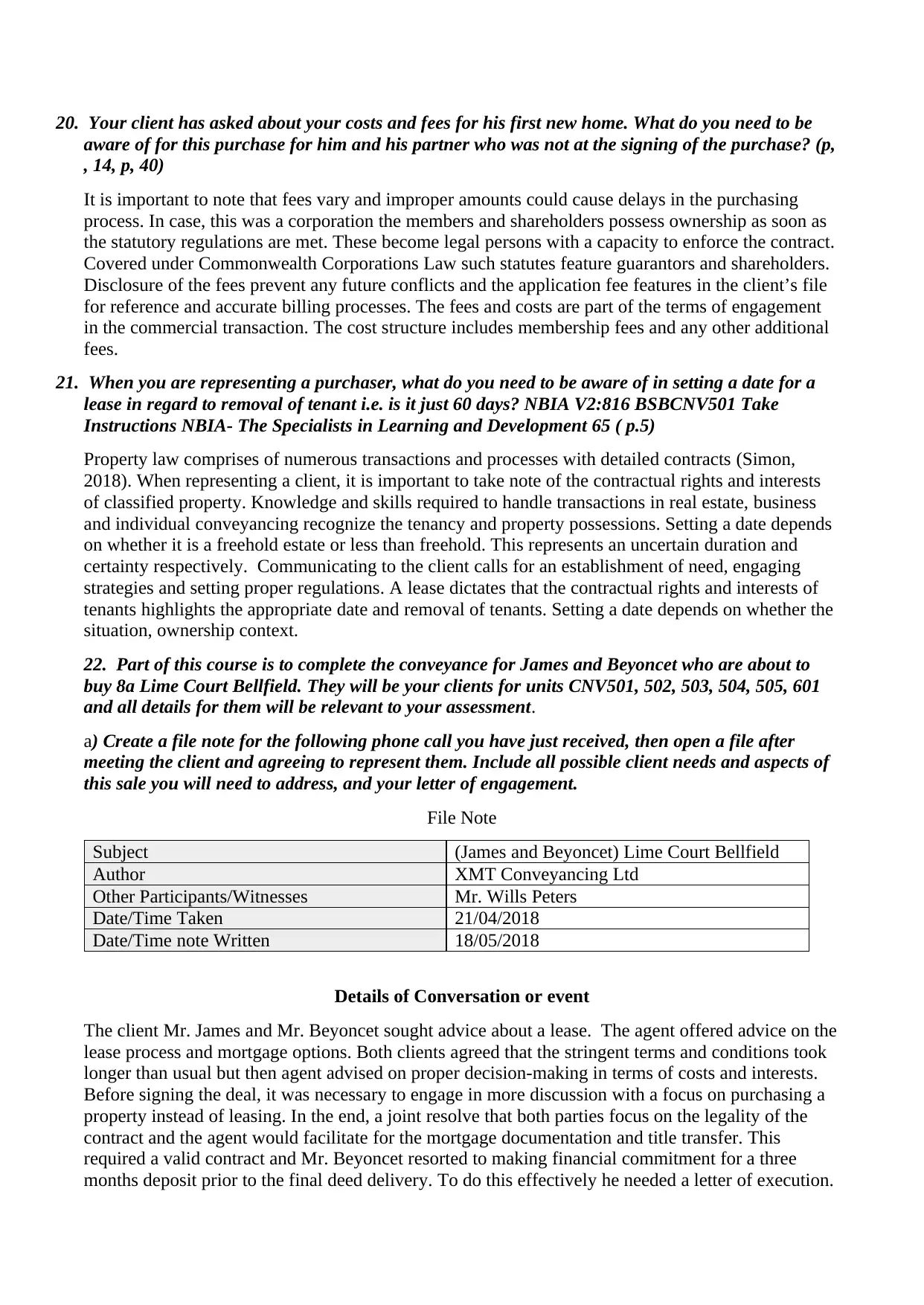
20. Your client has asked about your costs and fees for his first new home. What do you need to be
aware of for this purchase for him and his partner who was not at the signing of the purchase? (p,
, 14, p, 40)
It is important to note that fees vary and improper amounts could cause delays in the purchasing
process. In case, this was a corporation the members and shareholders possess ownership as soon as
the statutory regulations are met. These become legal persons with a capacity to enforce the contract.
Covered under Commonwealth Corporations Law such statutes feature guarantors and shareholders.
Disclosure of the fees prevent any future conflicts and the application fee features in the client’s file
for reference and accurate billing processes. The fees and costs are part of the terms of engagement
in the commercial transaction. The cost structure includes membership fees and any other additional
fees.
21. When you are representing a purchaser, what do you need to be aware of in setting a date for a
lease in regard to removal of tenant i.e. is it just 60 days? NBIA V2:816 BSBCNV501 Take
Instructions NBIA- The Specialists in Learning and Development 65 ( p.5)
Property law comprises of numerous transactions and processes with detailed contracts (Simon,
2018). When representing a client, it is important to take note of the contractual rights and interests
of classified property. Knowledge and skills required to handle transactions in real estate, business
and individual conveyancing recognize the tenancy and property possessions. Setting a date depends
on whether it is a freehold estate or less than freehold. This represents an uncertain duration and
certainty respectively. Communicating to the client calls for an establishment of need, engaging
strategies and setting proper regulations. A lease dictates that the contractual rights and interests of
tenants highlights the appropriate date and removal of tenants. Setting a date depends on whether the
situation, ownership context.
22. Part of this course is to complete the conveyance for James and Beyoncet who are about to
buy 8a Lime Court Bellfield. They will be your clients for units CNV501, 502, 503, 504, 505, 601
and all details for them will be relevant to your assessment.
a) Create a file note for the following phone call you have just received, then open a file after
meeting the client and agreeing to represent them. Include all possible client needs and aspects of
this sale you will need to address, and your letter of engagement.
File Note
Subject (James and Beyoncet) Lime Court Bellfield
Author XMT Conveyancing Ltd
Other Participants/Witnesses Mr. Wills Peters
Date/Time Taken 21/04/2018
Date/Time note Written 18/05/2018
Details of Conversation or event
The client Mr. James and Mr. Beyoncet sought advice about a lease. The agent offered advice on the
lease process and mortgage options. Both clients agreed that the stringent terms and conditions took
longer than usual but then agent advised on proper decision-making in terms of costs and interests.
Before signing the deal, it was necessary to engage in more discussion with a focus on purchasing a
property instead of leasing. In the end, a joint resolve that both parties focus on the legality of the
contract and the agent would facilitate for the mortgage documentation and title transfer. This
required a valid contract and Mr. Beyoncet resorted to making financial commitment for a three
months deposit prior to the final deed delivery. To do this effectively he needed a letter of execution.
aware of for this purchase for him and his partner who was not at the signing of the purchase? (p,
, 14, p, 40)
It is important to note that fees vary and improper amounts could cause delays in the purchasing
process. In case, this was a corporation the members and shareholders possess ownership as soon as
the statutory regulations are met. These become legal persons with a capacity to enforce the contract.
Covered under Commonwealth Corporations Law such statutes feature guarantors and shareholders.
Disclosure of the fees prevent any future conflicts and the application fee features in the client’s file
for reference and accurate billing processes. The fees and costs are part of the terms of engagement
in the commercial transaction. The cost structure includes membership fees and any other additional
fees.
21. When you are representing a purchaser, what do you need to be aware of in setting a date for a
lease in regard to removal of tenant i.e. is it just 60 days? NBIA V2:816 BSBCNV501 Take
Instructions NBIA- The Specialists in Learning and Development 65 ( p.5)
Property law comprises of numerous transactions and processes with detailed contracts (Simon,
2018). When representing a client, it is important to take note of the contractual rights and interests
of classified property. Knowledge and skills required to handle transactions in real estate, business
and individual conveyancing recognize the tenancy and property possessions. Setting a date depends
on whether it is a freehold estate or less than freehold. This represents an uncertain duration and
certainty respectively. Communicating to the client calls for an establishment of need, engaging
strategies and setting proper regulations. A lease dictates that the contractual rights and interests of
tenants highlights the appropriate date and removal of tenants. Setting a date depends on whether the
situation, ownership context.
22. Part of this course is to complete the conveyance for James and Beyoncet who are about to
buy 8a Lime Court Bellfield. They will be your clients for units CNV501, 502, 503, 504, 505, 601
and all details for them will be relevant to your assessment.
a) Create a file note for the following phone call you have just received, then open a file after
meeting the client and agreeing to represent them. Include all possible client needs and aspects of
this sale you will need to address, and your letter of engagement.
File Note
Subject (James and Beyoncet) Lime Court Bellfield
Author XMT Conveyancing Ltd
Other Participants/Witnesses Mr. Wills Peters
Date/Time Taken 21/04/2018
Date/Time note Written 18/05/2018
Details of Conversation or event
The client Mr. James and Mr. Beyoncet sought advice about a lease. The agent offered advice on the
lease process and mortgage options. Both clients agreed that the stringent terms and conditions took
longer than usual but then agent advised on proper decision-making in terms of costs and interests.
Before signing the deal, it was necessary to engage in more discussion with a focus on purchasing a
property instead of leasing. In the end, a joint resolve that both parties focus on the legality of the
contract and the agent would facilitate for the mortgage documentation and title transfer. This
required a valid contract and Mr. Beyoncet resorted to making financial commitment for a three
months deposit prior to the final deed delivery. To do this effectively he needed a letter of execution.
Paraphrase This Document
Need a fresh take? Get an instant paraphrase of this document with our AI Paraphraser
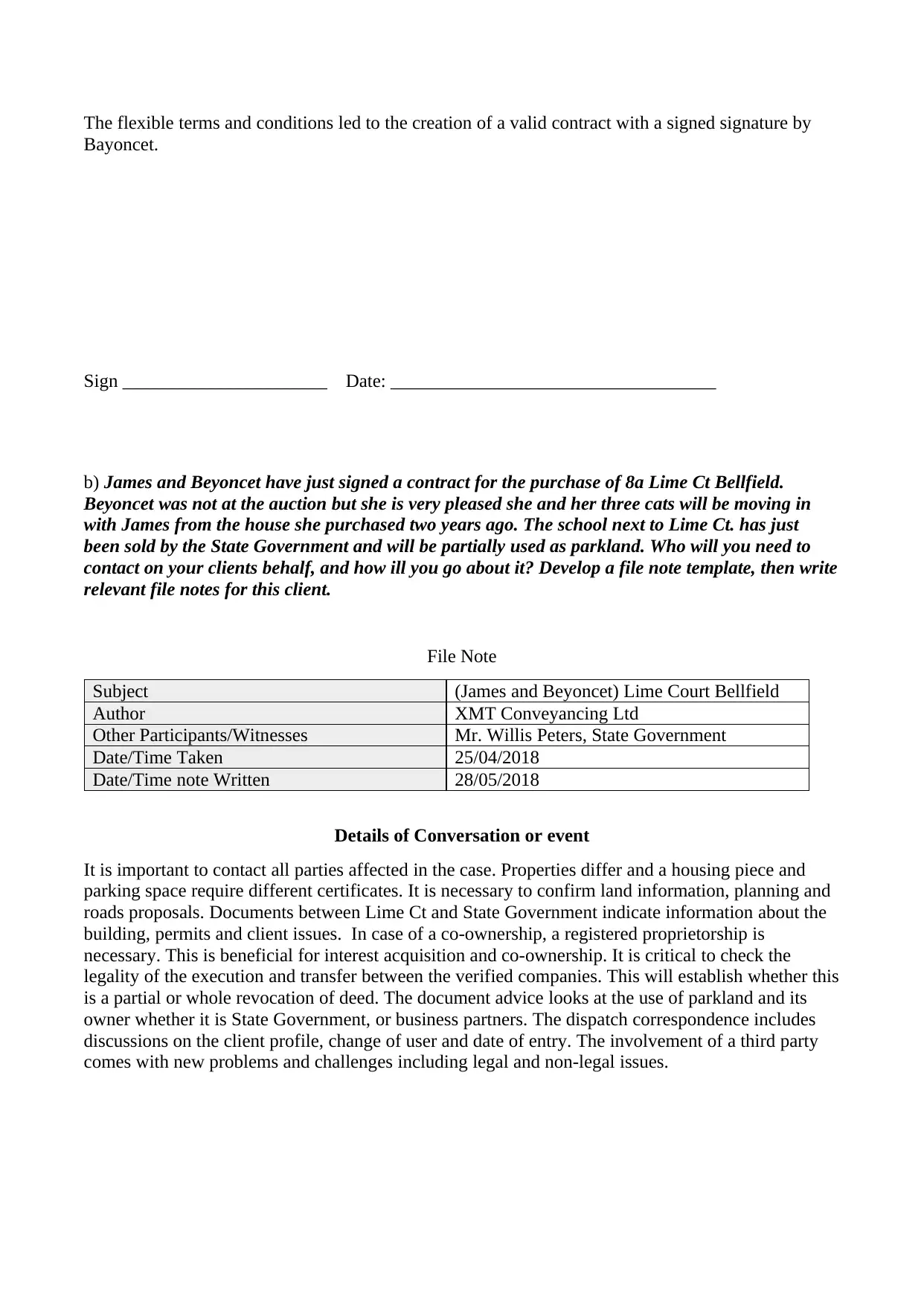
The flexible terms and conditions led to the creation of a valid contract with a signed signature by
Bayoncet.
Sign ______________________ Date: ___________________________________
b) James and Beyoncet have just signed a contract for the purchase of 8a Lime Ct Bellfield.
Beyoncet was not at the auction but she is very pleased she and her three cats will be moving in
with James from the house she purchased two years ago. The school next to Lime Ct. has just
been sold by the State Government and will be partially used as parkland. Who will you need to
contact on your clients behalf, and how ill you go about it? Develop a file note template, then write
relevant file notes for this client.
File Note
Subject (James and Beyoncet) Lime Court Bellfield
Author XMT Conveyancing Ltd
Other Participants/Witnesses Mr. Willis Peters, State Government
Date/Time Taken 25/04/2018
Date/Time note Written 28/05/2018
Details of Conversation or event
It is important to contact all parties affected in the case. Properties differ and a housing piece and
parking space require different certificates. It is necessary to confirm land information, planning and
roads proposals. Documents between Lime Ct and State Government indicate information about the
building, permits and client issues. In case of a co-ownership, a registered proprietorship is
necessary. This is beneficial for interest acquisition and co-ownership. It is critical to check the
legality of the execution and transfer between the verified companies. This will establish whether this
is a partial or whole revocation of deed. The document advice looks at the use of parkland and its
owner whether it is State Government, or business partners. The dispatch correspondence includes
discussions on the client profile, change of user and date of entry. The involvement of a third party
comes with new problems and challenges including legal and non-legal issues.
Bayoncet.
Sign ______________________ Date: ___________________________________
b) James and Beyoncet have just signed a contract for the purchase of 8a Lime Ct Bellfield.
Beyoncet was not at the auction but she is very pleased she and her three cats will be moving in
with James from the house she purchased two years ago. The school next to Lime Ct. has just
been sold by the State Government and will be partially used as parkland. Who will you need to
contact on your clients behalf, and how ill you go about it? Develop a file note template, then write
relevant file notes for this client.
File Note
Subject (James and Beyoncet) Lime Court Bellfield
Author XMT Conveyancing Ltd
Other Participants/Witnesses Mr. Willis Peters, State Government
Date/Time Taken 25/04/2018
Date/Time note Written 28/05/2018
Details of Conversation or event
It is important to contact all parties affected in the case. Properties differ and a housing piece and
parking space require different certificates. It is necessary to confirm land information, planning and
roads proposals. Documents between Lime Ct and State Government indicate information about the
building, permits and client issues. In case of a co-ownership, a registered proprietorship is
necessary. This is beneficial for interest acquisition and co-ownership. It is critical to check the
legality of the execution and transfer between the verified companies. This will establish whether this
is a partial or whole revocation of deed. The document advice looks at the use of parkland and its
owner whether it is State Government, or business partners. The dispatch correspondence includes
discussions on the client profile, change of user and date of entry. The involvement of a third party
comes with new problems and challenges including legal and non-legal issues.
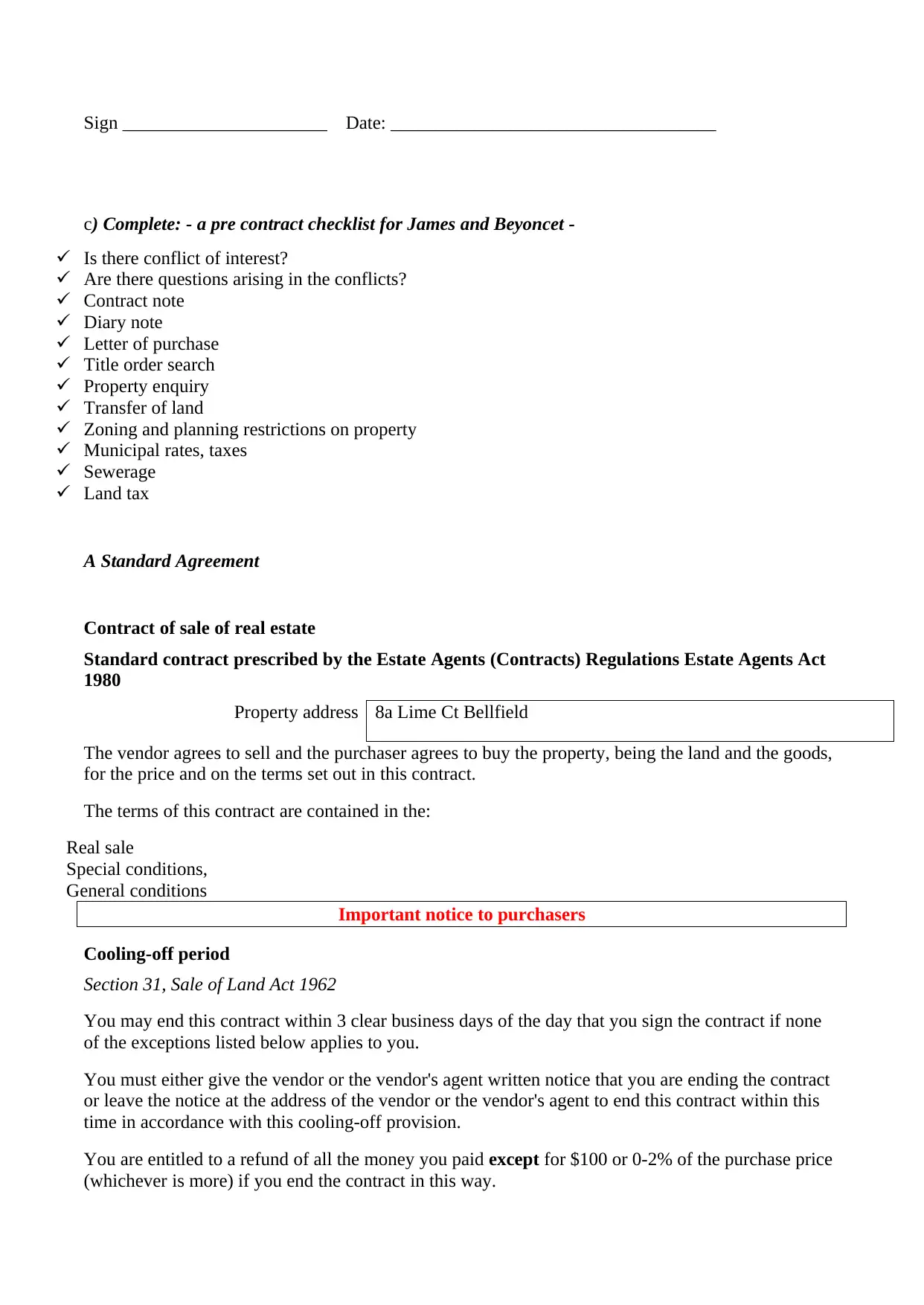
Sign ______________________ Date: ___________________________________
c) Complete: - a pre contract checklist for James and Beyoncet -
Is there conflict of interest?
Are there questions arising in the conflicts?
Contract note
Diary note
Letter of purchase
Title order search
Property enquiry
Transfer of land
Zoning and planning restrictions on property
Municipal rates, taxes
Sewerage
Land tax
A Standard Agreement
Contract of sale of real estate
Standard contract prescribed by the Estate Agents (Contracts) Regulations Estate Agents Act
1980
Property address 8a Lime Ct Bellfield
The vendor agrees to sell and the purchaser agrees to buy the property, being the land and the goods,
for the price and on the terms set out in this contract.
The terms of this contract are contained in the:
Real sale
Special conditions,
General conditions
Important notice to purchasers
Cooling-off period
Section 31, Sale of Land Act 1962
You may end this contract within 3 clear business days of the day that you sign the contract if none
of the exceptions listed below applies to you.
You must either give the vendor or the vendor's agent written notice that you are ending the contract
or leave the notice at the address of the vendor or the vendor's agent to end this contract within this
time in accordance with this cooling-off provision.
You are entitled to a refund of all the money you paid except for $100 or 0-2% of the purchase price
(whichever is more) if you end the contract in this way.
c) Complete: - a pre contract checklist for James and Beyoncet -
Is there conflict of interest?
Are there questions arising in the conflicts?
Contract note
Diary note
Letter of purchase
Title order search
Property enquiry
Transfer of land
Zoning and planning restrictions on property
Municipal rates, taxes
Sewerage
Land tax
A Standard Agreement
Contract of sale of real estate
Standard contract prescribed by the Estate Agents (Contracts) Regulations Estate Agents Act
1980
Property address 8a Lime Ct Bellfield
The vendor agrees to sell and the purchaser agrees to buy the property, being the land and the goods,
for the price and on the terms set out in this contract.
The terms of this contract are contained in the:
Real sale
Special conditions,
General conditions
Important notice to purchasers
Cooling-off period
Section 31, Sale of Land Act 1962
You may end this contract within 3 clear business days of the day that you sign the contract if none
of the exceptions listed below applies to you.
You must either give the vendor or the vendor's agent written notice that you are ending the contract
or leave the notice at the address of the vendor or the vendor's agent to end this contract within this
time in accordance with this cooling-off provision.
You are entitled to a refund of all the money you paid except for $100 or 0-2% of the purchase price
(whichever is more) if you end the contract in this way.
⊘ This is a preview!⊘
Do you want full access?
Subscribe today to unlock all pages.

Trusted by 1+ million students worldwide
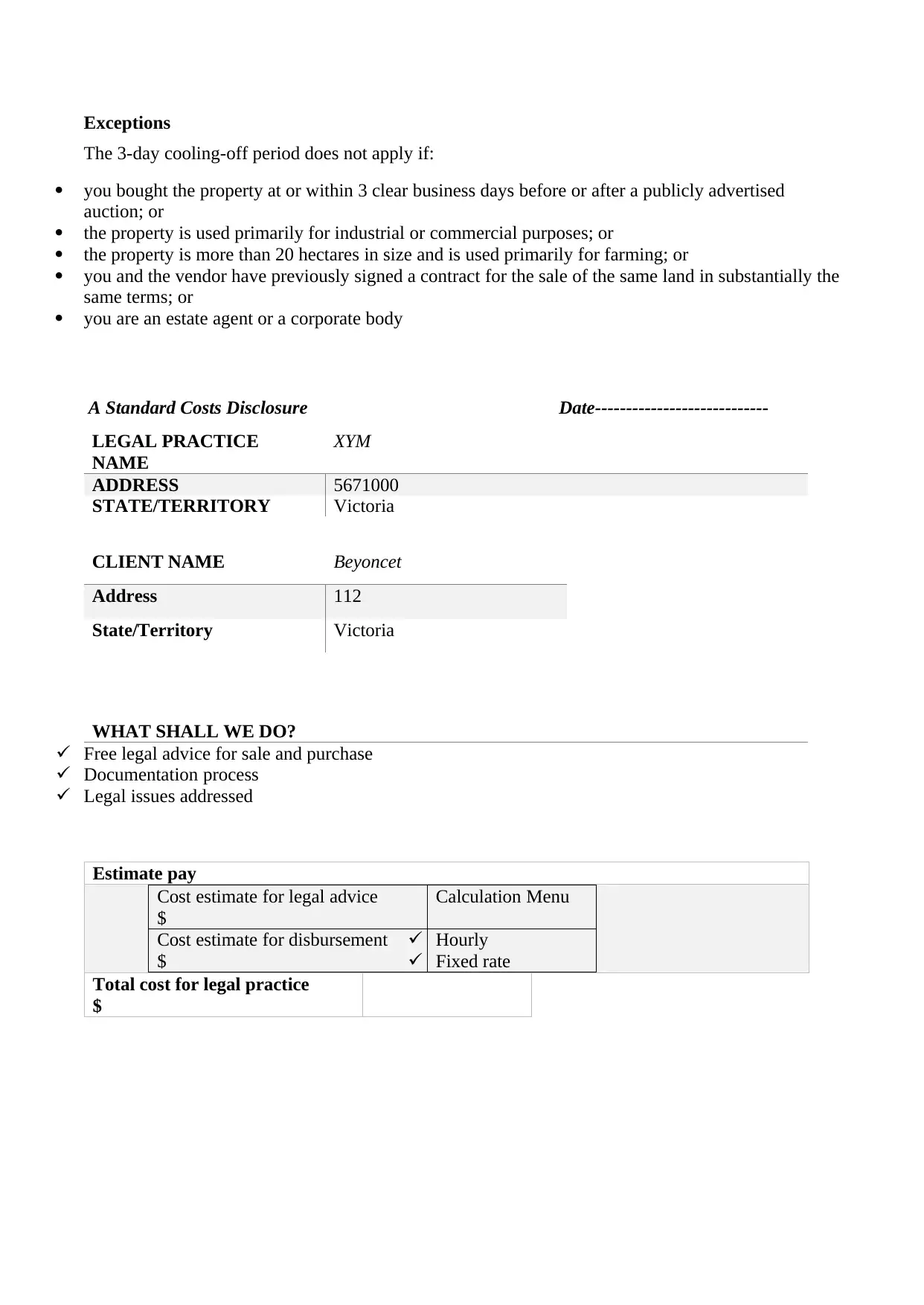
Exceptions
The 3-day cooling-off period does not apply if:
you bought the property at or within 3 clear business days before or after a publicly advertised
auction; or
the property is used primarily for industrial or commercial purposes; or
the property is more than 20 hectares in size and is used primarily for farming; or
you and the vendor have previously signed a contract for the sale of the same land in substantially the
same terms; or
you are an estate agent or a corporate body
A Standard Costs Disclosure Date----------------------------
LEGAL PRACTICE
NAME
XYM
ADDRESS 5671000
STATE/TERRITORY Victoria
CLIENT NAME Beyoncet
Address 112
State/Territory Victoria
WHAT SHALL WE DO?
Free legal advice for sale and purchase
Documentation process
Legal issues addressed
Estimate pay
Cost estimate for legal advice
$
Calculation Menu
Cost estimate for disbursement
$
Hourly
Fixed rate
Total cost for legal practice
$
The 3-day cooling-off period does not apply if:
you bought the property at or within 3 clear business days before or after a publicly advertised
auction; or
the property is used primarily for industrial or commercial purposes; or
the property is more than 20 hectares in size and is used primarily for farming; or
you and the vendor have previously signed a contract for the sale of the same land in substantially the
same terms; or
you are an estate agent or a corporate body
A Standard Costs Disclosure Date----------------------------
LEGAL PRACTICE
NAME
XYM
ADDRESS 5671000
STATE/TERRITORY Victoria
CLIENT NAME Beyoncet
Address 112
State/Territory Victoria
WHAT SHALL WE DO?
Free legal advice for sale and purchase
Documentation process
Legal issues addressed
Estimate pay
Cost estimate for legal advice
$
Calculation Menu
Cost estimate for disbursement
$
Hourly
Fixed rate
Total cost for legal practice
$
Paraphrase This Document
Need a fresh take? Get an instant paraphrase of this document with our AI Paraphraser
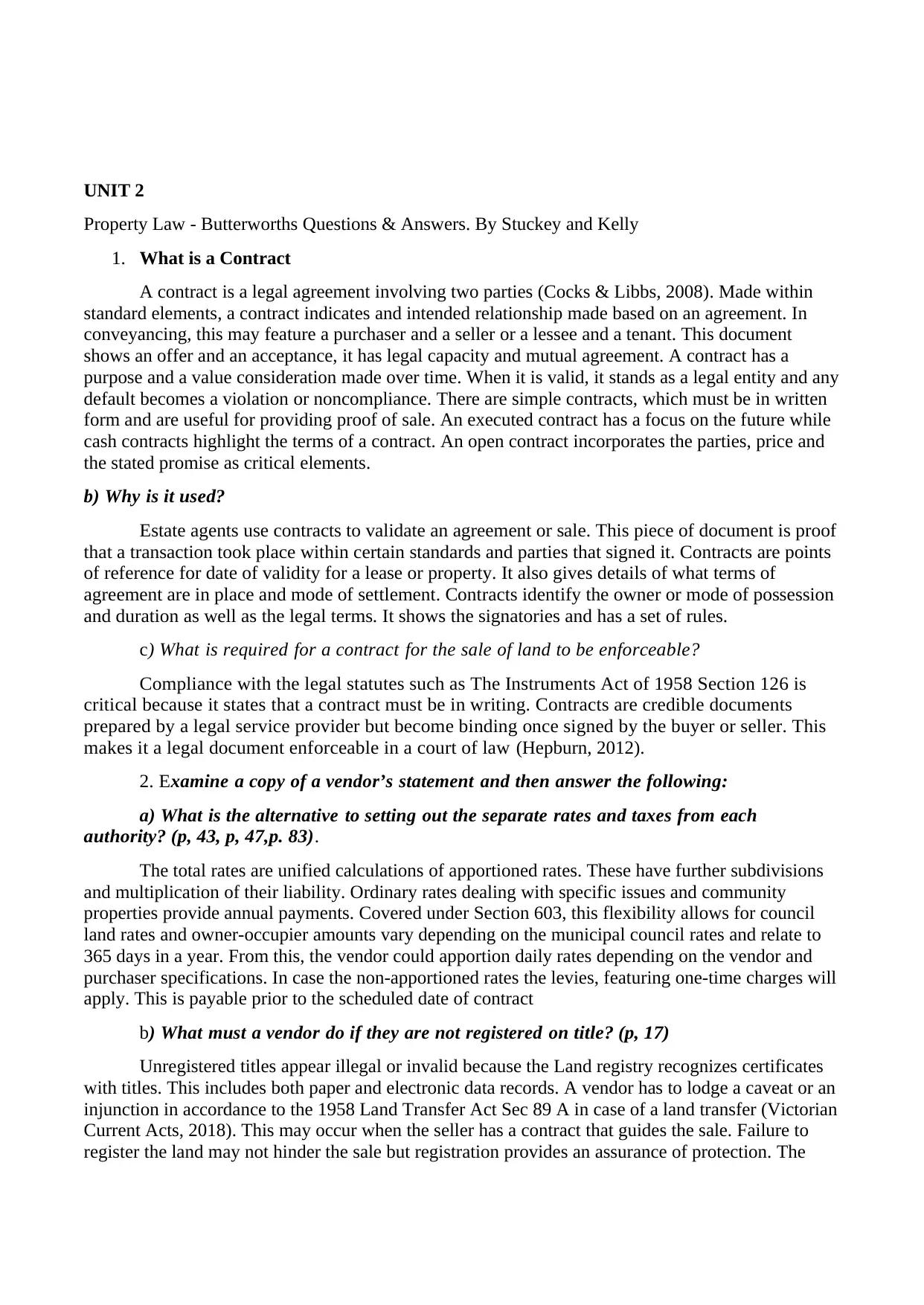
UNIT 2
Property Law - Butterworths Questions & Answers. By Stuckey and Kelly
1. What is a Contract
A contract is a legal agreement involving two parties (Cocks & Libbs, 2008). Made within
standard elements, a contract indicates and intended relationship made based on an agreement. In
conveyancing, this may feature a purchaser and a seller or a lessee and a tenant. This document
shows an offer and an acceptance, it has legal capacity and mutual agreement. A contract has a
purpose and a value consideration made over time. When it is valid, it stands as a legal entity and any
default becomes a violation or noncompliance. There are simple contracts, which must be in written
form and are useful for providing proof of sale. An executed contract has a focus on the future while
cash contracts highlight the terms of a contract. An open contract incorporates the parties, price and
the stated promise as critical elements.
b) Why is it us e d?
Estate agents use contracts to validate an agreement or sale. This piece of document is proof
that a transaction took place within certain standards and parties that signed it. Contracts are points
of reference for date of validity for a lease or property. It also gives details of what terms of
agreement are in place and mode of settlement. Contracts identify the owner or mode of possession
and duration as well as the legal terms. It shows the signatories and has a set of rules.
c) What is required for a contract for the sale of land to be enfor ceabl e?
Compliance with the legal statutes such as The Instruments Act of 1958 Section 126 is
critical because it states that a contract must be in writing. Contracts are credible documents
prepared by a legal service provider but become binding once signed by the buyer or seller. This
makes it a legal document enforceable in a court of law (Hepburn, 2012) .
2. Examine a copy of a vendor’s statement and then answer the fo llo wing :
a) What is the alternative to setting out the separate rates and taxes from each
a uthor it y? (p, 43, p, 47,p. 83).
The total rates are unified calculations of apportioned rates. These have further subdivisions
and multiplication of their liability. Ordinary rates dealing with specific issues and community
properties provide annual payments. Covered under Section 603, this flexibility allows for council
land rates and owner-occupier amounts vary depending on the municipal council rates and relate to
365 days in a year. From this, the vendor could apportion daily rates depending on the vendor and
purchaser specifications. In case the non-apportioned rates the levies, featuring one-time charges will
apply. This is payable prior to the scheduled date of contract
b) What must a vendor do if they are not registered on title? (p, 17)
Unregistered titles appear illegal or invalid because the Land registry recognizes certificates
with titles. This includes both paper and electronic data records. A vendor has to lodge a caveat or an
injunction in accordance to the 1958 Land Transfer Act Sec 89 A in case of a land transfer (Victorian
Current Acts, 2018). This may occur when the seller has a contract that guides the sale. Failure to
register the land may not hinder the sale but registration provides an assurance of protection. The
Property Law - Butterworths Questions & Answers. By Stuckey and Kelly
1. What is a Contract
A contract is a legal agreement involving two parties (Cocks & Libbs, 2008). Made within
standard elements, a contract indicates and intended relationship made based on an agreement. In
conveyancing, this may feature a purchaser and a seller or a lessee and a tenant. This document
shows an offer and an acceptance, it has legal capacity and mutual agreement. A contract has a
purpose and a value consideration made over time. When it is valid, it stands as a legal entity and any
default becomes a violation or noncompliance. There are simple contracts, which must be in written
form and are useful for providing proof of sale. An executed contract has a focus on the future while
cash contracts highlight the terms of a contract. An open contract incorporates the parties, price and
the stated promise as critical elements.
b) Why is it us e d?
Estate agents use contracts to validate an agreement or sale. This piece of document is proof
that a transaction took place within certain standards and parties that signed it. Contracts are points
of reference for date of validity for a lease or property. It also gives details of what terms of
agreement are in place and mode of settlement. Contracts identify the owner or mode of possession
and duration as well as the legal terms. It shows the signatories and has a set of rules.
c) What is required for a contract for the sale of land to be enfor ceabl e?
Compliance with the legal statutes such as The Instruments Act of 1958 Section 126 is
critical because it states that a contract must be in writing. Contracts are credible documents
prepared by a legal service provider but become binding once signed by the buyer or seller. This
makes it a legal document enforceable in a court of law (Hepburn, 2012) .
2. Examine a copy of a vendor’s statement and then answer the fo llo wing :
a) What is the alternative to setting out the separate rates and taxes from each
a uthor it y? (p, 43, p, 47,p. 83).
The total rates are unified calculations of apportioned rates. These have further subdivisions
and multiplication of their liability. Ordinary rates dealing with specific issues and community
properties provide annual payments. Covered under Section 603, this flexibility allows for council
land rates and owner-occupier amounts vary depending on the municipal council rates and relate to
365 days in a year. From this, the vendor could apportion daily rates depending on the vendor and
purchaser specifications. In case the non-apportioned rates the levies, featuring one-time charges will
apply. This is payable prior to the scheduled date of contract
b) What must a vendor do if they are not registered on title? (p, 17)
Unregistered titles appear illegal or invalid because the Land registry recognizes certificates
with titles. This includes both paper and electronic data records. A vendor has to lodge a caveat or an
injunction in accordance to the 1958 Land Transfer Act Sec 89 A in case of a land transfer (Victorian
Current Acts, 2018). This may occur when the seller has a contract that guides the sale. Failure to
register the land may not hinder the sale but registration provides an assurance of protection. The
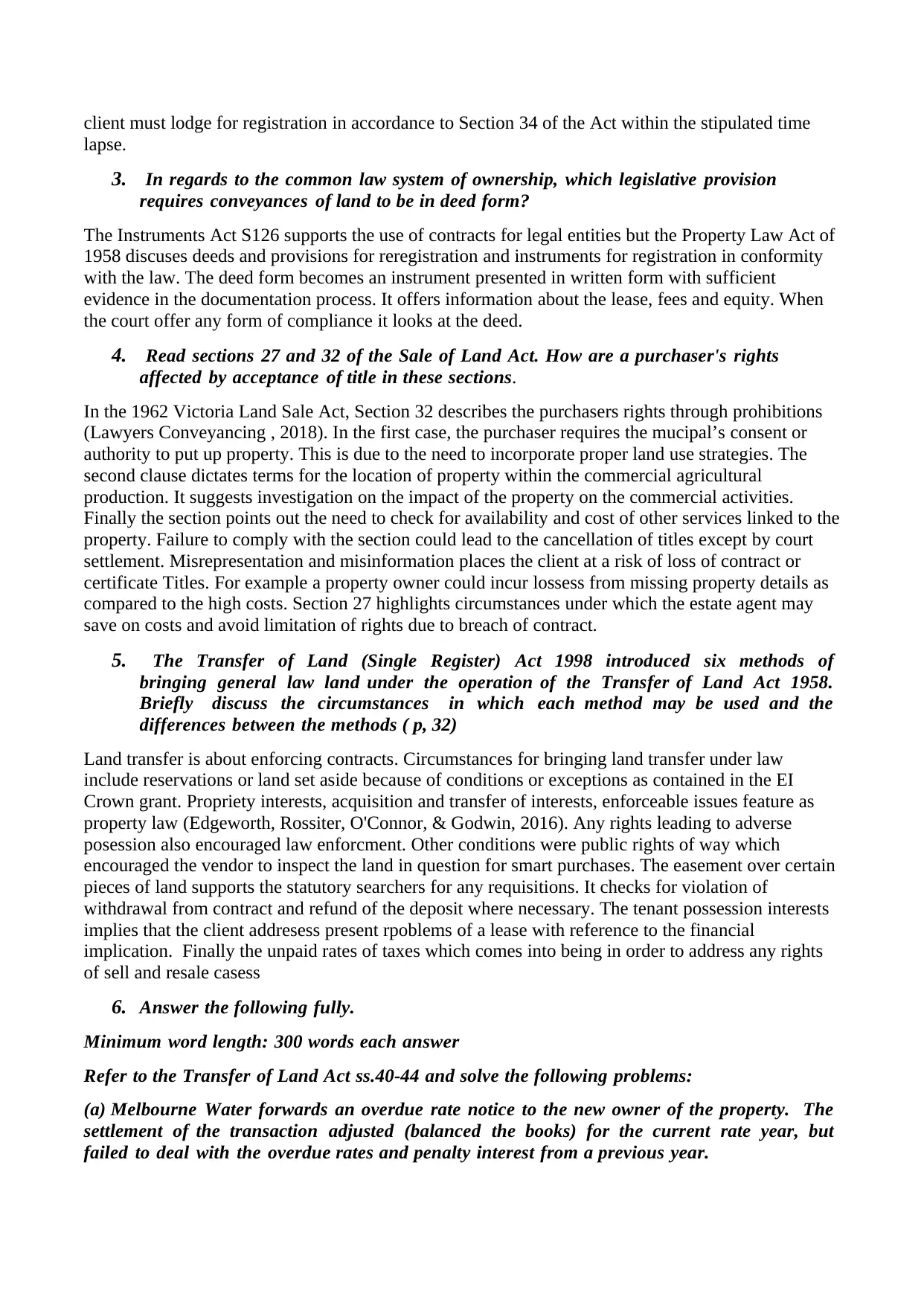
client must lodge for registration in accordance to Section 34 of the Act within the stipulated time
lapse.
3. In regards to the common law system of ownership, which legislative provision
requires conveyances of land to be in deed form ?
The Instruments Act S126 supports the use of contracts for legal entities but the Property Law Act of
1958 discuses deeds and provisions for reregistration and instruments for registration in conformity
with the law. The deed form becomes an instrument presented in written form with sufficient
evidence in the documentation process. It offers information about the lease, fees and equity. When
the court offer any form of compliance it looks at the deed.
4. Read sections 27 and 32 of the Sale of Land Act. How are a purchaser's rights
affected by acceptance of title in these s ectio ns.
In the 1962 Victoria Land Sale Act, Section 32 describes the purchasers rights through prohibitions
(Lawyers Conveyancing , 2018). In the first case, the purchaser requires the mucipal’s consent or
authority to put up property. This is due to the need to incorporate proper land use strategies. The
second clause dictates terms for the location of property within the commercial agricultural
production. It suggests investigation on the impact of the property on the commercial activities.
Finally the section points out the need to check for availability and cost of other services linked to the
property. Failure to comply with the section could lead to the cancellation of titles except by court
settlement. Misrepresentation and misinformation places the client at a risk of loss of contract or
certificate Titles. For example a property owner could incur lossess from missing property details as
compared to the high costs. Section 27 highlights circumstances under which the estate agent may
save on costs and avoid limitation of rights due to breach of contract.
5. The Transfer of Land (Single Register) Act 1998 introduced six methods of
bringing general law la nd under the operation of the Transfer of Land Act 1958.
Briefly discuss the circumstances in which eac h method may be used and the
differences between the m e thods ( p, 32)
Land transfer is about enforcing contracts. Circumstances for bringing land transfer under law
include reservations or land set aside because of conditions or exceptions as contained in the EI
Crown grant. Propriety interests, acquisition and transfer of interests, enforceable issues feature as
property law (Edgeworth, Rossiter, O'Connor, & Godwin, 2016). Any rights leading to adverse
posession also encouraged law enforcment. Other conditions were public rights of way which
encouraged the vendor to inspect the land in question for smart purchases. The easement over certain
pieces of land supports the statutory searchers for any requisitions. It checks for violation of
withdrawal from contract and refund of the deposit where necessary. The tenant possession interests
implies that the client addresess present rpoblems of a lease with reference to the financial
implication. Finally the unpaid rates of taxes which comes into being in order to address any rights
of sell and resale casess
6. Answer the following ful l y.
Minimum word length: 300 words each answ er
Refer to the Transfer of Land Act ss.40-44 and solve the following probl e ms :
(a) Melbourne Water forwards an overdue rate notice to the new owner of the property. The
settlement of the transaction adjusted (balanced the books) for the current rate year, but
failed to deal with the ov e rdu e rates and penalty interest from a previous y ea r.
lapse.
3. In regards to the common law system of ownership, which legislative provision
requires conveyances of land to be in deed form ?
The Instruments Act S126 supports the use of contracts for legal entities but the Property Law Act of
1958 discuses deeds and provisions for reregistration and instruments for registration in conformity
with the law. The deed form becomes an instrument presented in written form with sufficient
evidence in the documentation process. It offers information about the lease, fees and equity. When
the court offer any form of compliance it looks at the deed.
4. Read sections 27 and 32 of the Sale of Land Act. How are a purchaser's rights
affected by acceptance of title in these s ectio ns.
In the 1962 Victoria Land Sale Act, Section 32 describes the purchasers rights through prohibitions
(Lawyers Conveyancing , 2018). In the first case, the purchaser requires the mucipal’s consent or
authority to put up property. This is due to the need to incorporate proper land use strategies. The
second clause dictates terms for the location of property within the commercial agricultural
production. It suggests investigation on the impact of the property on the commercial activities.
Finally the section points out the need to check for availability and cost of other services linked to the
property. Failure to comply with the section could lead to the cancellation of titles except by court
settlement. Misrepresentation and misinformation places the client at a risk of loss of contract or
certificate Titles. For example a property owner could incur lossess from missing property details as
compared to the high costs. Section 27 highlights circumstances under which the estate agent may
save on costs and avoid limitation of rights due to breach of contract.
5. The Transfer of Land (Single Register) Act 1998 introduced six methods of
bringing general law la nd under the operation of the Transfer of Land Act 1958.
Briefly discuss the circumstances in which eac h method may be used and the
differences between the m e thods ( p, 32)
Land transfer is about enforcing contracts. Circumstances for bringing land transfer under law
include reservations or land set aside because of conditions or exceptions as contained in the EI
Crown grant. Propriety interests, acquisition and transfer of interests, enforceable issues feature as
property law (Edgeworth, Rossiter, O'Connor, & Godwin, 2016). Any rights leading to adverse
posession also encouraged law enforcment. Other conditions were public rights of way which
encouraged the vendor to inspect the land in question for smart purchases. The easement over certain
pieces of land supports the statutory searchers for any requisitions. It checks for violation of
withdrawal from contract and refund of the deposit where necessary. The tenant possession interests
implies that the client addresess present rpoblems of a lease with reference to the financial
implication. Finally the unpaid rates of taxes which comes into being in order to address any rights
of sell and resale casess
6. Answer the following ful l y.
Minimum word length: 300 words each answ er
Refer to the Transfer of Land Act ss.40-44 and solve the following probl e ms :
(a) Melbourne Water forwards an overdue rate notice to the new owner of the property. The
settlement of the transaction adjusted (balanced the books) for the current rate year, but
failed to deal with the ov e rdu e rates and penalty interest from a previous y ea r.
⊘ This is a preview!⊘
Do you want full access?
Subscribe today to unlock all pages.

Trusted by 1+ million students worldwide
1 out of 32
Your All-in-One AI-Powered Toolkit for Academic Success.
+13062052269
info@desklib.com
Available 24*7 on WhatsApp / Email
![[object Object]](/_next/static/media/star-bottom.7253800d.svg)
Unlock your academic potential
Copyright © 2020–2025 A2Z Services. All Rights Reserved. Developed and managed by ZUCOL.
